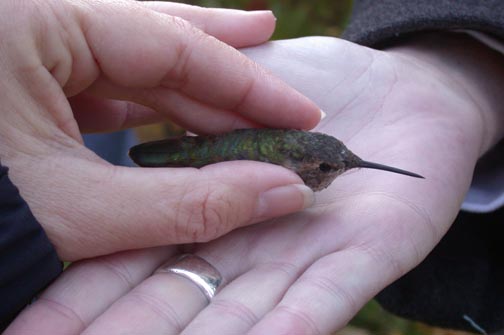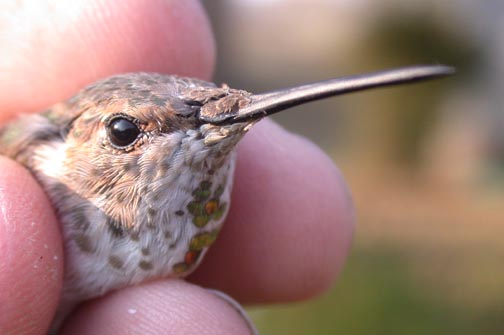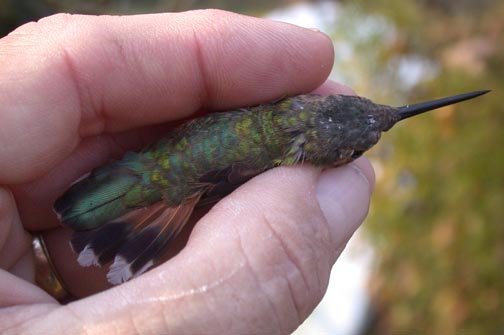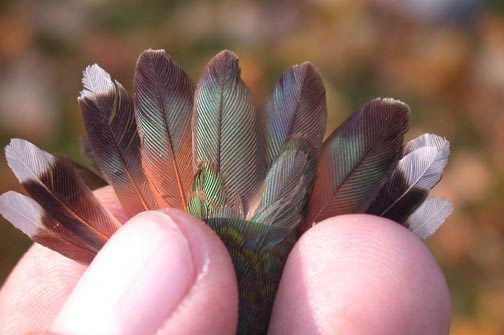|
|
Banding Data
Location Code: VAN5
Click here to view written description.
|
||||||||||
| Description |
Michigan Rare Bird Report Species: Rufous Hummingbird (Selasphorus rufus), immature female Date & Time: November 9, 2007. First observed by homeowner on approximately October 15 2007 and still present as of this writing (November 10, 2007). I arrived around 9:00 a.m., set up my trap at 9:15 a.m., and caught the bird at 9:17 a.m. The bird was banded and released at 9:35 a.m. under Federal permit No. 23156, and Michigan permit No. SC 1303. After release the bird returned three times and was recaptured on the third time at 9:58. The trap was kept open because the homeowner and a local birder had reported two hummingbirds present, but that was not the case on this day. Location: At the home of Dan and Jackie Skarritt near Bangor, Van Buren Co. Observer (s): All data and observations in this report were made by Allen Chartier. Brenda Keith, Rich Keith, Jon Wuepper, Caleb Putnam, and Lu Robertson were also present. Equipment: Photographed in-hand with digital camera (photos attached to this document). All measurements were made using digital calipers. Bill corrugations were determined by viewing through a 10x loupe, as they are impossible to accurately determine any other way. Viewing conditions: The sky was mostly clear and the light was good. The bird was banded, measured, and weighed, indoors and photographed outdoors. Description: The bird was not observed prior to being captured for banding. Once in-hand, it was aged, sexed, and identified in that order. The proper use of Stiles (1972) for banders requires that an individual Rufous/Allenís Hummingbird in-hand be correctly aged and sexed before a species determination can be made (B. Sargent and N. Newfield, pers. comm.). Age: The bird was aged as hatch-year (immature) based on the presence of shallow groovings or corrugations on about 50% of the upper mandible. This individual showed a somewhat atypical pattern of corrugations, with a gap near the base, creating a "saddle" of corrugations that has been associated with second-year females, but in this bird the saddle was only on one side, and on the other side was much fainter, but more extensive corrugations. This is universally recognized as the most reliable method for age determination in hummingbirds (Ortiz-Crespo, 1972). Sex: The upper tail coverts and rump were entirely green. The rufous on the base of the central rectrix (r1) was restricted to about the basal 25%, and was completely covered by the green upper tail coverts. These characters suggested this bird was a female. The wing measurement of 43.25 mm was longer than any age of male Allenís given in Stiles (1972) and was at the upper extreme for immature male Rufous but well within the range for immature females. The bill measurement (exposed culmen) can sometimes be helpful for determining sex. This birdís exposed culmen measurement of 17.81 mm was longer than immature male Rufous in addition to being longer than immature males of nominate (S. s. sasin) Allenís Hummingbird, but within range for both males and females of the sedentarius subspecies* of Allenís. So, the bill measurement supports the sex as female. The pattern of iridescent gorget feathers on the throat can sometimes be helpful in determining the sex of Selasphorus hummingbirds. This bird had 11 clustered together in the center of the throat (see photos). This pattern could occur in either immature males or females, and the number of iridescent feathers varies considerably and is not particularly useful for supporting an age determination. There is a tendency for immature males and immature females to have fewer iridescent feathers, so this birdís throat pattern weakly supports it as an immature female. Species: Given that the bird was a hatch-year (immature) female, using Stiles (1972) we can determine whether this bird was a Rufous or Allenís Hummingbird using several additional measurements and observations. The presence of notching and/or emargination on the second rectrix from the center (r2) is one feature that can often be observed in the field to confirm Rufous. This individual had no significant emargination on either web of the second rectrix (see photos), which would make this bird impossible to identify in the field. Using Figure 3 in Stiles (1972), the shape most closely matched figure Ca. In my experience, most immature females have r2 shaped like this, and even a few adult females do too. Given that the r2 did not show the diagnostic shape of Rufous, the widths of two other tail feathers, the central rectrix (r1) and the outermost rectrix (r5) needed to be measured. The width of the central rectrix (r1) was measured as 8.02 mm. This is near the low end of the range for immature female Rufous (7.8-9.5 mm) given in Stiles (1972), and near the upper end of the range for immature female of nominate (S. s. sasin) Allenís (6.9-8.2 mm). It is near the middle of the range for the sedentarius subspecies of Allenís (7.3-8.4 mm). So, the width of the central rectrix is suggestive of Rufous, but not conclusive. The width of the outer rectrix (r5) was measured as 3.97 mm. This is broader than the maximum range for immature female Allenís (max. 3.3 mm) for both subspecies, and so provides the only conclusive and diagnostic support to the identification as Rufous Hummingbird. Tail measurements are often not very useful. This birdís tail measurement of 26.1 mm is above the maximum for immature females of the nominate subspecies of Allenís (Stiles gives no corresponding measurement for immature female S. s. sedentarius). So tail length is somewhat useful in this case. Molt: There was extensive body molt evident on this bird. The outer 5 primaries (p6-p10) were old and worn, p5 was grown in about 40%, p4 was grown in about 70%, and the inner primaries (p1-p3) were recently replaced and contrastingly shiny black. The central (r1), second (r2) and fifth (r5) rectrices were all fresh, while r3 and r4 were old and worn. Fat/Weight: The bird had a fat code of 1 (0-3 scale) and weighed 3.60 grams, about average for an immature female planning to overwinter. Voice: Brief, sharp chatter when the bird was released. More strident than Ruby-throated gives. Similar Species: Allenís Hummingbird is the species most similar to Rufous Hummingbird. On this bird, the diagnostic measured width of the outer (r5) rectrix was the primary character confirming the identification, with tail length supporting the identification. Experience: I have seen dozens of Rufous Hummingbirds in several states, banded 41 in Michigan, Ohio, Indiana, and Ontario, and handled ~35 in Louisiana in February 2003 with Nancy Newfield, and handled about a dozen in Arizona in July 2006 helping other banders. I have seen several Allenís Hummingbirds on two trips to California and once recently in Arizona, and handled 3 in Louisiana in February 2003. As a trained, licensed hummingbird bander, I am familiar with all pertinent in-hand criteria for distinguishing Rufous from Allenís Hummingbird, in addition to known field criteria for separating these species. When report was written: This report was written on November 10, 2007 based on data and photos taken during the banding process. * There are two subspecies of Allen's Hummingbird. One is the widespread and migratory nominate subspecies (Selasphorus sasin sasin) breeding from coastal northern California to coastal southern California and mainly migrating southward into Baja California, Mexico. The other is a more range-restricted and generally non-migratory subspecies (S. s. sedentarius), breeding on California's Channel Islands and the adjacent mainland (around Los Angeles). But sedentarius presents some problems, because it is intermediate between S. s. sasin and Rufous in some characters. And, while sasin has a shorter bill than Rufous, sedentarius has a longer bill! If sedentarius were entirely sedentary, this would not be an issue. But, I've been told (N. Newfield, pers. comm.) that the first specimen of Allen's Hummingbird collected in Louisiana actually fits sedentarius! So, however remote the possibility, sedentarius must also be considered. References consulted: None were consulted while observing the bird in the field, nor were any used to write notes in the field or to write this report. Stiles (1972) and Pyle (1997) were available during the banding of the bird. References: Ortiz-Crespo, F.I. 1972. A new method to separate immature and adult hummingbirds. Auk 89: 851-857. Pyle, P. 1997. Identification Guide to North American Birds: Stiles, F.G. 1972. Age and Sex Determination in Rufous and Allen Hummingbirds. The Condor 74: 25-32.
|
||||||||||
| Photos |  |
||||||||||
 |
|||||||||||
 |
|||||||||||
 |
|||||||||||

